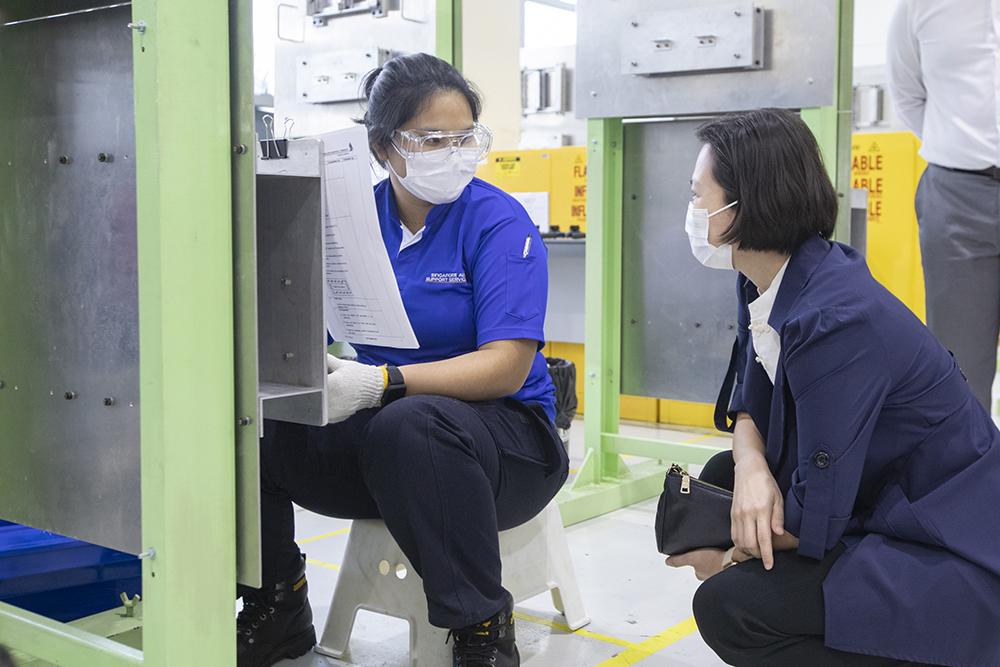
Collins Aerospace
Collins Aerospace launched a Singapore Innovation Hub in 2020 at its Changi MRO campus, where it aims to deliver more than 40 proofs of concept (POC) by 2025. It is currently working to roll out two POC projects within the next 12-18 months, including an online customer portal that will enable customers to view real-time updates 24/7, as well as RFID technology for parts tracking.

Collins Aerospace
The Singapore facility has also introduced a robotic machine vision system, nicknamed “Spot,” which it is using to automatically conduct inventory inspections for the Pratt & Whitney PW1000G Geared Turbofan (GTF) build-up quick engine change (QEC) kit. Spot is comprised of high-resolution cameras, a cobot arm and an autonomous mobile robot that can move around the GTF engine without human intervention. It is able to inspect 159 different items on the QEC kit, which Collins says has reduced man-hours by 70% during inventory inspections. According to Collins, Spot could easily be programmed for other engine types, depending on demand requirements.

AirAsia
AirAsia Group is looking at several areas for new digital services, according to chief operations officer Javed Malik. It has created a marketplace product in-house that deploys elements of blockchain for more secure sales of rotables and consumables. It also sees potential in using drones to monitor aircraft fuselage damage and cracks, so it is starting up a drone business and training school.
To pursue better predictive maintenance, AirAsia Group’s data team has built algorithms and smart dashboards related to aircraft and engine performance that it expects to monetize in the future as a data services offering for other carriers. According to Malik, AirAsia’s internal data about fleet performance has produced more than $120 million in savings on fuel performance alone over the past five years.

HAECO
Earlier this year, HAECO Hong Kong’s On-wing Structure Support (OSS) team introduced remote digital inspection capability in response to COVID-19 challenges. Its mechanics and inspectors wear voice-controlled smart glasses paired with a communication interface that is accessible via computer or mobile device, which enables real-time collaboration with remote experts. They can use the system to follow digital workflows, take photos, share files and capture field data. The OSS team used the technology in July to complete an on-wing nacelle modification in collaboration with an OEM.
According to HAECO, its OSS team is continuing to leverage the technology in other aircraft maintenance projects. It is also using the system in its Xiamen facilities to improve communication between the cockpit and the ground during maintenance operations.

Singapore Airlines Engineering Co.
Singapore Airlines Engineering Co. (SIAEC) has spent 2021 pushing ahead with phase 2 of its planned transformation program. It is investing around S$40 million (approximately $29.7 million) in digitalization and automation projects, such as a mobile app for line maintenance engineers called SMART MX, which will enable access to information on-the-go. It is also developing an engine lifter that it expects to reduce the time and manpower required for an engine change on widebody aircraft by approximately 50%.

SIAEC
SIAEC is also pursuing efficiencies through adoption of Lean methodologies. SIAEC launched its new Lean Academy earlier this month, which it will use to train staff through interactive e-learning modules, instructor-led classes and practical training on the shop floor. It also plans to eventually offer Lean training to the greater MRO community through its SIAEC Training Academy.

ST Engineering
This year ST Engineering introduced robotics to automate floor grid drilling during passenger-to-freighter conversions. It has applied the automated drilling process on one of its ongoing conversion programs in Singapore and plans to roll the initiative out to its other conversion facilities in China and Europe as it ramps up conversion capacity. It says the robotic drilling solution could also be used for other repeatable manufacturing processes such as fastener installation, milling and welding.
ST Engineering is also using advanced predictive analytics in its expert system modeling for CFM56 engines and drones to conduct aircraft inspections.

ST Engineering
ST Engineering has invested in new technologies for greener operations this year. In addition to its new partnership with Artificial Intelligence of Things specialist Envision Digital to build a cloud-based, smart digital building solution aimed at achieving net zero carbon, it has added solar power capacity to three of its aerospace facilities. In April it added solar roofs at its Paya Lebar facility in eastern Singapore, and it expects the three solar-equipped facilities to generate up to 30% of its annual electricity needs.

Sri Lankan Airlines
Sri Lankan Airlines is working toward upgrading its enterprise resource planning system by the second quarter of 2022. The new platform will have enhanced capabilities, including mobile device-based paperless operations.
It is also exploring possible use of big data analytics for predictive maintenance, 3D printing, enhanced inspection methods and robotic automation systems.

Dragon Aviation Capital
Singapore-based aircraft and engine leasing specialist Dragon Aviation Capital has begun offering digitalized aircraft records due to increased demand during the COVID-19 pandemic. It provides an aircraft records scanning service to tailor digital documents to a lessor or operator’s requirements. The digital records are fully searchable through optical character recognition text and accessible via a secure cloud service.

Starburst
Over the last year, aerospace accelerator Starburst has expanded into the Asia-Pacific region to promote and pursue technology innovation in the region. It opened a new subsidiary in Mumbai that will look into potential investments in areas such as MRO, urban air mobility and software startups.
Starburst also launched a new Aviation Tech Accelerator Program in Singapore. The program will accelerate 10 aviation startups annually that provide technology aimed at solving challenge areas shared by airlines, MROs and other areas within the aviation ecosystem. Its first cohort of startups includes: Evitado, which has created a high-tech collision warning system to avoid damaging aircraft while they moving in maintenance and airport environments; MyrLabs, which has created a system using indoor positioning robots and Internet of Things technologies for industrial use cases; and tomorrow.io, a platform that uses machine learning to drive weather insights, which in the aviation industry could be used to maximize operations efficiency and safety by proactively scheduling staff, flights or tasks like runway maintenance.
A rundown of new MRO technology projects taking place at airlines, MROs, aftermarket providers and startups in the Asia-Pacific region.
